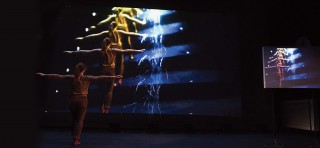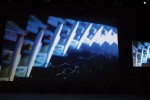Title

The annual Beyond the Machine concerts spotlight Juilliard musicians creating and performing demanding electro-acoustic music. This year's series unfolds over two weekends. The first, BTM 16.1, is a presentation of works-in-progress, some of which Journal reporter Joseph Bricker and others saw in a November series of presentations.The second, BTM 16.2 eVirtuosos, features works by Juilliard composers including the following.
Body
Transformation by second-year master's violinist Mariam Machiadze (BM '14, violin), who holds Irving Billig and Ann Scovell Gordon Memorial scholarships
I based this composition on ideas and responses to sounds created in real time by Max 7 [software]; the solo violin part is completely improvisatory and it creates a very active side of the piece compared with the electronic part, which has a calm character and sort of represents an emotional wave in a magnified glass.
Shifting Sands by second-year master's composition student Saad Haddad
Shifting Sands wavers between the distinctive strands of Western and Arabic music seeking to fuse the evocative, otherworldly sound of the maqam (scale in Arabic) within a Western scheme and tonality. Its structure is influenced by tarab (Arabic for a continuous state of musical ecstasy), which, in an abstract sense, is akin to the monolithic presence of the Arabian deserts as a backdrop for the hundreds of thousands of nomads that have traversed their ancient sands. Through live electronics, I've discovered that it's possible to accentuate the major hallmarks of Arabic music in ways that can't be done acoustically. For example, the spiritual characteristics of the maqamat (scales) are difficult to pin down for a Western player since there are a plethora of microtonal inflections to consider. Live electronics help by processing a performer's stable pitch (i.e., the tonic or fifth of an Arabic scale) through a pitch shifter, which produces the exact microtone above or below the processed pitch for that particular scale. Many of these microtones aren't based on conventionally known quarter- tone or even sixth-tone systems, and live electronics produce an effect true to the maqamat that wouldn't otherwise be possible.
Liittatllye by second-year jazz master's student Ruaridh Pattison, who holds Victor Herbert, Illinois Jacquet, and Satterthwaite scholarships
When I was learning the saxophone, I bought an electronic wind instrument (EWI) to try and emulate Michael Brecker, the only person to have ever mastered it. It's a lot harder than it looks, and it languished in a cupboard for almost four years before I picked it up again in the last year so I could practice late at night in my apartment. Around the same time, I took [faculty member and alum] Mari Kimura's Introduction to Interactive Music Technology class because I'd developed an interest in improvising musicians who were using the visual programming language MaxMSP, and my main project used the EWI.
FluteStep by Trevor Bumgarner (MM '15, composition)
In high school I was a metal guitarist (read: noise), but I put that away once I got into college to focus on traditional classical music studies. A few years later, it occurred to me, Why not bring these two together? FluteStep is like a big dance party in a flute player's head, with hundreds of flutes jamming and all the sounds coming from just one flute playing a simple scale. What interests me about working with technology is its endless possibilities: If you can think it, you can create it. But just because you can do everything doesn't mean you should do everything. All art is judged by its own rules, and with technology, sometimes we need to remember to make them.
Lament by fourth-year trumpeter Theo Van Dyck, who holds Frieda and Harry Aronson Scholarship in Trumpet and the Emanuel and Blanche Weinstock Scholarship
I'm a trumpeter and writer of spoken-word poetry, and technology lets me combine my passions. I started using technology to further my musical interests when I was 14—I would make simple beats and pop songs, often recording my trumpet and altering the sound to create new sounds. Lament starts with a single melodic line from the trumpet that's then looped via pedal in real time, with the loops followed by a spoken-word verse set in a near future in which the advancement of technology has overshadowed traditional ways of seeking enjoyment. After the verse, an improvised trumpet solo builds to end the piece.






